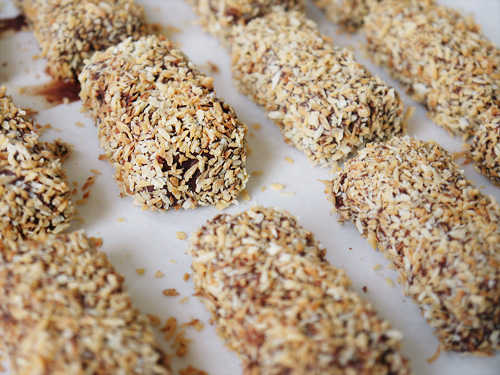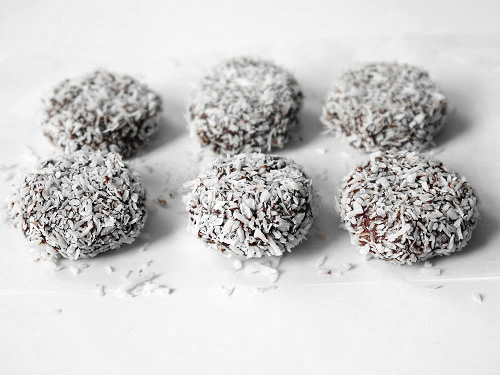The elegant arcades of Paris are dotted with pâtisseries selling dainty macarons in vibrant colours and all manner of exotic flavours. All very sophisticated and famous the world over.
Well, today I present one of Scotland’s national sweets: the macaroon bar. It’s about a million miles from the French macaron. They both contain sugar and the names are a little bit similar, but that’s about as far as it goes.
The Scottish macaroon bar is something of tooth-aching sweetness. It has a snowy-white intensely sugary interior that has been dipped in chocolate and then rolled in toasted coconut. This is probably as bad as sweets can get (and a dentist’s worst nightmare) but it has a firm place on the heart of a nation that, well, loves just about anything that is very, very, very sweet.
You might also wonder where the name comes from – is this in any way linked to the French macaron? The answer is…I don’t know. But here in Britain, coconut macaroons are quite common, so I think it is the addition of the coconut that gives rise to the name. Just a hunch.
Now, you might be looking at these things and thinking “wow, that looks an awful lot like a peppermint cream/pattie“ then you are sort of right. The filling is like fondant, but it hides a surprise. Whereas true fondant centres involve boiling sugary syrups to the right temperature, then working the syrup on cool marble surfaces with spatulas and kneading them to encourage the formation of the right type of sugar crystals, macaroon bars take a shortcut. And that shortcut (and I promise I am not making this up) is to use cooled mashed potato.
That’s right. Potato!
It seems surprising, but you mix one part potato to four to five parts icing (confectioner’s) sugar, and hey presto – a smooth filling that is easy to work and just as sweet as the more complex version. What this does mean, of course, is that if you are making this with kids on a rainy afternoon, it’s very easy to do and much safer than leaving a toddler to work a tray of scalding sugar syrup. Of course, it won’t do their teeth any good, but this is of course not something that you would be making on a daily basis.
The profess of making them takes a little time, but it’s actually quite easy. You start with the potato, which looks like it won’t ever take the best part of a kilogram of sugar. But with the first addition, it turns from dry-looking mashed potato to a very sticky syrup. Looks odd, but keep going and it becomes firm and turns snowy-white. Then you chill it in the freezer, so that once you come to dip the pieces in chocolate, it sets quite quickly. But something I learned by macaroon bar number two was that you either need to work with a friend (one dipping, one rolling) or use one hand for dipping, and keep the other free for the rolling. Otherwise you end up with fingers covered in chocolate, coated in coconut, and one very, very big mess in the kitchen.
The bar shape is classic, but once I’d cut the fontant into strips, I ended up with a few scraps. Clearly worried that I didn’t have enough highly sugary sweets already, and as I still had ample chocolate left, I rolled the fondant into balls, flattened them slightly, and dipped them in chocolate and rolled them in untoasted coconut. I think that they look rather pretty. Who knows, they could even take off as the must-have petits fours for smart dinner parties!
To make macaroon bars (makes 18-20):
• 1 large potato (100g after boiling)
• 400-500g icing sugar
• 2-3 drops vanilla extract
• 300g dark chocolate
• 100g dessicated coconut
Boil the potato until soft. Drain, measure out 100g, then mash until there are no lumps, and leave until cold.
Put the cold mashed potato, vanilla extract and 100g of icing sugar in a bowl. Mix well – the potato might seem very dry, but it will change into a very thick, sticky paste. Keep adding the icing sugar, 100g at a time, mixing well after each addition, until you have a stiff white fondant.
Line a tray with greaseproof paper, put the fondant in the tray, and press flat. Cover with cling film and leave in the freezer for an hour.
In the meantime, toast the coconut in the oven – spread thinly on a large baking sheet and cook in the oven at 150°C (300°F) for around 5 minutes until the coconut is just golden. Watch it carefully – it can burn very easily. Remove from the oven and allow to cool.
Remove the fondant from the freezer. Cut into bars (mine were finger length and just wider than finger width).
Melt the chocolate in a bowl above a pan of barely simmering water. Once the chocolate is melted and smooth, dip each piece of the sugar paste into the chocolate, then roll in the coconut. Transfer to a sheet of greasproof paper and allow to set.
Worth making? This is quite a fun and easy recipe to try. It’s super-sweet, so not something you would make often, but worth having a go at!








Well, these look amazing! Also, I just checked out your foodgawker gallery – lovely photos!
Thanks!
Oh gosh, I love this recipe!
Got to make that! Thanks for sharing!
Good luck – hope they turn out well!
Oh my, this is a total nostalgia trip. Thanks for posting this! I had no idea that potato was ever used in the fondants.
I know, very retro. The potato was a bit of a surprise to me, and I was dubious that it would work. But it did!
Awesome macaroons. Hope the sloe gin comes out well.
Pingback: TipsTuesday: Guide to Halloween treats! « THE ECOHAWKS
Pingback: Halloween: Spicy Pumpkin Soup | LondonEats
Fantastic recipe for me to do with the children in the local school when I do cookery workshops!
Reminds me of my childhood 😉 Thanks for posting.
Good idea to serve them as petit fours as they are super sweet.
Oh my goodness that brought back lots of memories – I’d forgotten all about these!
Hi – I just found this recipe through Pinterest – I live in Maine USA and the sweet of choice here is called Needhams and guess what – it is exactly the same as these macaroons but with coconut – who knew? Thanks for the recipe – Patricia
Hi Patricia – that’s so funny – I had no idea! I did a little checking, and I found them – I see you’ve got coconut on the inside, and then they’re coated in chocolate. Nice to see that macaroon bars made it over to Maine
Don’t be put off by the potato, honestly, it tastes yummy, I would say I always use a medium potato and 1kg of icing sugar, the potato goes far and always have spare icing sugar at hand. If you pinch a small piece off b4 you place it in the freezer and you still have a potato taste, add a few droos of water and more icing suger, hope this helps and I haven’t intruded on the sites expertise,
You’re so right that a little potato goes a long way. I thought that the fluffy mashed potato would take just a little icing sugar…but no, it turned into a thin, runny paste! But keep adding the sugar…and then like magic, it comes together. Thanks for the “pinch” tip too!
Pingback: Unlikely things to do with a potato: Scottish macaroons |
Love this recipe, thanks for sharing!
Thanks, glad you like it!
Hi just wondering how far in advance can you make the macaroons. Was hoping to pug in Christmas hampers?
Thanks in advance
Hi Eleanor – I’m not sure how long them will keep for – I would not keep them for more than two or three days as there isn’t anything in there to stop them spoiling. Sorry I can’t be more helpful!
Do you add milk or butter to make the mash potato
Hi Robert – sorry I didn’t get back sooner. You don’t add any milk or butter – when you add the sugar to the mashed potato, it will get very wet and sticky, so if you add any milk, you will just have to add more icing sugar to get it to come together into a fondant mixture.
I should also say you want to use a floury potato, not a waxy potato for this!